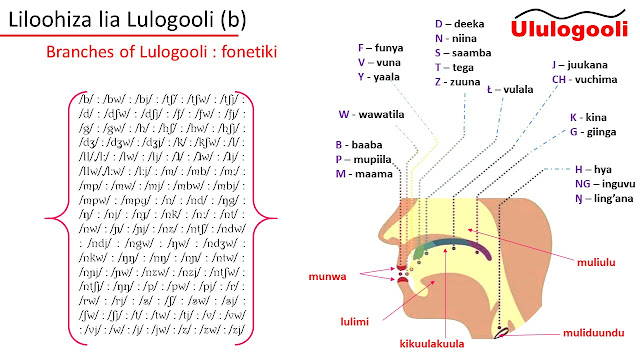Featured
- Get link
- X
- Other Apps
Branches of Lulogooli and their interdependence
Ululogooli can be together viewed as a union of three factors; sound, form and meaning. In many cases the native speaker overlooks form, becoming an expert of sounds and meaning. It is important, for writing, to dwell on form as it can decrease or increase sound and meaning in word and sentence construction.
a. Branches (Zihya)
These are the different topics under which Lulogooli can be further studied. It includes sounds, words, articulation, sentences, semantics and pragmatics.
b. Phonetics (fonetiki)
The sound systems have their own places of articulation in the mouth. Some are pronounced on the lips while others back in the glottal. Some are soft while others require friction.
c. Morhology (mofologi)
Word building of Lulogooli is CVCV format. To mean that syllables play a great role. And with syllables we have consonant and a vowel, C+V. The end sound is that of a vowel. One or more syllables create word meaning.
d. Phonology (fonologi)
Having been able to form words, it will be found out that some are written same (homogulafu), some not written same but pronounced same (homofoni) and some words have more than one meaning (homonimu). More word characteristics include opposites (Viamugoongo) and relatedmeaning (sinonimu).
e. Sentenses (Zivaaso na zintakisi)
A sentence, away from the basic meaning to inform, ask, declare or show emotion, can also be used to answer the five W’s and 1 h; what, who, when, why, where and how. These help in communication as the intended message is the one that is received.
f. Semantics (semantiki)
Words are responsible for creating more words, scenarios leading to others. This interconnectedness of things make Ululogooli fun. A tale would shift from a person to an animal to a tree to a stone swiftly as words are shared or borrowed.
g. Pragmatics (puragimatiki)
Language in use among the Valogooli ranges from simple sounds to complex constructs of not only grammatical challenge but also meaning wise. It is important, in such a case, to study this in light of structural Lulogooli for pragmatics mainly come to play in direct speech.
- Get link
- X
- Other Apps







Comments
Post a Comment